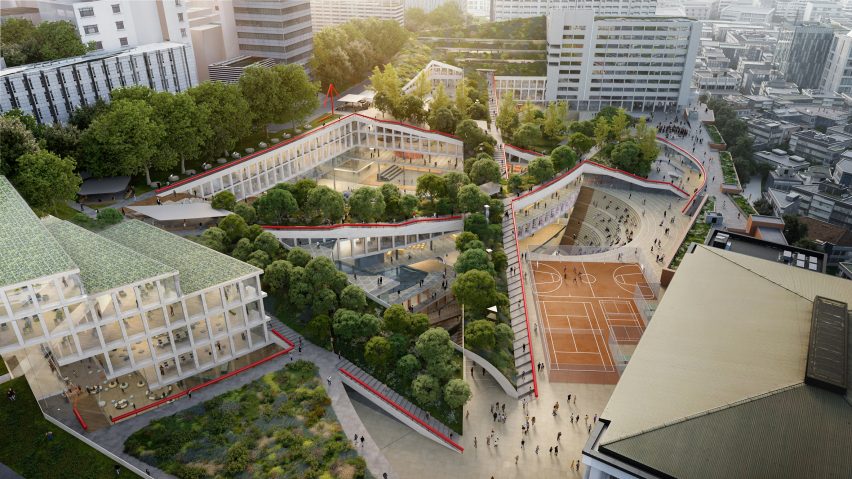A cluster of buildings and courtyards that act as "a natural extension" of a mountain will define this campus expansion, which Dutch studio OMA is creating for Hongik University in Seoul.
The extension is being developed by OMA to simultaneously increase the amount of teaching facilities for the South Korean university and its available green space.
It will be predominantly positioned below ground level to blend in with the topography of the site, which sits on the slopes of the Wau-san mountain, with the aim of reducing its visual impact while better connecting the university to its surroundings.
"This is a project that shies away from conventional labels," said OMA partner Chris van Duijn.
"It is a building, a masterplan and landscape design all at once," he continued. "It purposely avoids [standing] out and invites to be discovered gradually. In doing so, it aims to reestablish the connection the university once had with the neighborhood."
Hongik University dates back to the 1950s. According to OMA, it had "reached the limits for expansion" due to its proximity to the mountain and built-up Hongdae district, but Seoul Metropolitan Government recently made a field beside it available for construction.
OMA's design was the winning entry of a competition, which studios including SANAA, Herzog & de Meuron, Renzo Piano Building Workshop and David Chipperfield Architects also entered.
The buildings in the proposal are arranged across the site in a series of interconnected clusters, "conceived as a natural extension" of Wau-san, OMA said.
They will extend below ground, allowing their roofs to double as pathways that provide links out to the Hongdae district, and will be lined with trees and greenery.
OMA's arrangement of buildings in each cluster will depend on their programme, which will include laboratories for the engineering faculty, makers spaces and general amenities for the university.
Outdoor courtyards that slope with the site will be slotted between, creating opportunities for light to enter the surrounding sunken buildings.
Other facilities will include an art centre and a multipurpose learning hub. OMA will also incorporate various facilities for the public in an effort to further connect the university to the surrounding district.
"We have designed a campus that lets itself be 'contaminated' with some of the energy, spontaneity, and creativity of the Hongdae neighborhood," said associate Ravi Kamisetti.
OMA, officially known as Office for Metropolitan Architecture, was founded in 1975 in Rotterdam by Rem Koolhaas, Elia Zenghelis, Madelon Vriesendorp and Zoe Zenghelis. The studio also has offices in New York, Doha, Sydney, Hong Kong, Beijing and Dubai.
Elsewhere, it is currently also developing a geometric skyscraper in Dhaka and a stepped shopping centre with glass facade in Tokyo.
The renders are by Negativ, courtesy of OMA.

